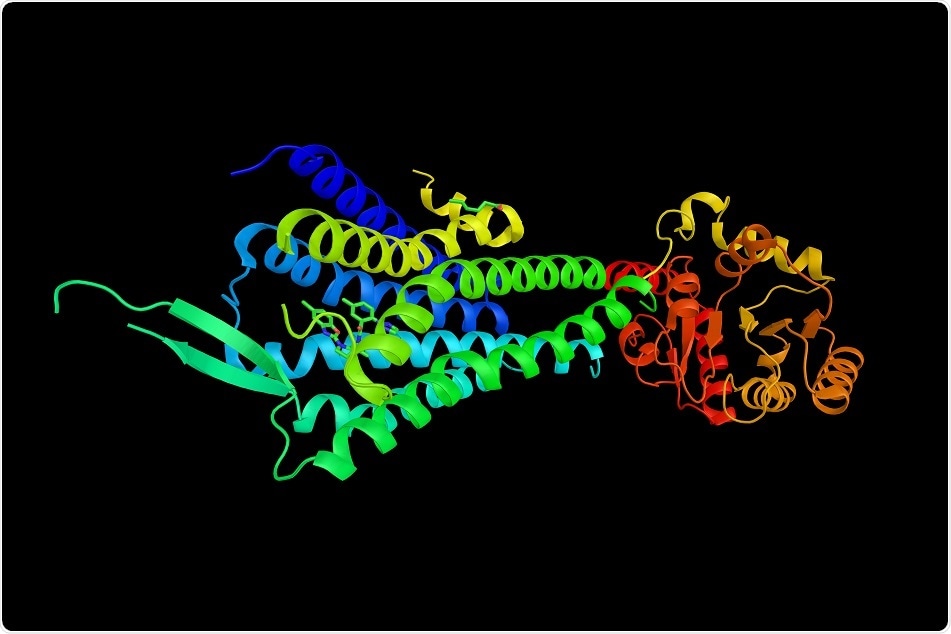By Jeyashree Sundaram, MBA
Oligomerization of G protein coupled receptors (GPCRs) is an interactive mechanism of radiation inactivation and ligand binding.
 Credit: ibreakstock.com/ Shutterstock.com
Credit: ibreakstock.com/ Shutterstock.com
It is a characteristic of cell membrane receptors, which is shared by GPCRs along with G-protein associates. The process of receptor oligomerization is assisted by the cell thermodynamics as well as the duration and selectivity of signals needed to attain the targets placed in several cellular compartments.
GPCR oligomerization in signaling
GPCRs act as oligomers to stimulate G protein and transducin and the evolution of oligomers affects the performance and range through which extracellular signals are transmitted to G protein molecules in the receptor transduction process.
The control of oligomer signaling plays a vital role in drug design, which entails the oligomers' pharmaceutical significance, its three-dimensional structural organization, and its occurrence between certain receptors.
Oligomeric constellations and oligomerization
Oligomerization has been investigated for diverse GPCR subfamilies, namely, family A and family B. Dimerization is a common term used to describe a heteromer or a homomer constellation. The term oligomerization is utilized for denoting dimeric, tetrameric, or higher order complexes among GPCR protomers.
These GPCR–GPCR interconnections are distinguished by certain parameters such as direct modulation of complementary function, specific spatial distance to each other, and physical interactions.
Physiological role of GPCR oligomerization
The functional importance of heteromerization and homomerization at the molecular level depends on the enlargement, determination, and tuning factors, including signal modification and amplification.
Furthermore, the capability of GPCR to form heteromers specifically allows their appropriate ligands to function in a synchronized manner and to stabilize and correlate the biological and cellular processes of reproduction and metabolism.
Various GPCRs bind with other GPCRs as oligomers to regulate the signals in distinct groups with associated physiological processes. This process becomes more complex for understanding the examined ligand properties, combined with numerous and varied GPCR targets like trace amines.
Receptors such as dopamine 2 receptor, dopamine 4 receptor, and alpha 1-adrenergic receptor support the participation of GPCR oligomerization as hetero-oligomer or homo-oligomer constellations in the control of physiological mechanisms.
Interaction among GPCR promoters
Interfaces of various GPCR–GPCR protomers have been stated with involvement of the extracellular N-terminus or transmembrane helix 1 (TMH1), TMH4, and TMH5-6.
The intermolecular interactions are formed between multiple or single amino acid side chains. Further, the specified roles of interaction mechanisms or spatial distances among protomers are not described for protomer interrelations as it varies for individual GPCRs.
Various interfaces of heterodimers and homodimers that are reported by biochemical or biophysical methods are established by the identified crystal structure of GPCR dimers. Moreover, interfaces of GPCR–GPCR possess dynamic characteristics and GPCRs are defined as a combination of homomers and monomers that undergo dynamic interconversion in the equilibrium condition.
GPCR molecular properties by oligomerization
Hetero and homo-oligomerization are not of much importance in the common signaling process, but it describes a major factor in signaling, i.e., fine-tuning. Oligomerization is involved in several properties of protomer interaction, including G-protein coupling selectivity, expression for cell surface, signal transduction process, and ligand binding.
Experimental detection of oligomers in GPCR
The common techniques that are involved in detection of oligomers are classified based on their experimental conditions and principles:
- non-dynamic and dynamic systems,
- in-vivo and in-vitro cell culture,
- antibody independent and antibody dependent
- analysis of fixed, living, or lysed cells.
Antibody-dependent techniques, including co-immunolocalization, co-immunoprecipitation, proximity ligation assay or sandwich-ELISA assay, primarily identifies the epitope tags.
Due to insufficient amounts of particular GPCR antibodies, these methods are usually restricted to in-vitro conditions of cell culture. The identification of heteromer and homomer molecules by antibody-dependent assays is predominantly utilized with GPCRs that are uniquely tagged with epitopes and they are efficient in lysed or fixed cells.
Further, the presence of antibodies in particular GPCR oligomers allows the identification of labeled GPCRs in animal models.
The antibody-independent technique identifies oligomers present in samples of living tissue or cells with enhanced approaches. The applications of protein complementation assay and resonance energy transfer (RET) are specifically used methods for detection of GPCR heteromerization or homomerization.
Furthermore, fluorescence fluctuation spectroscopy (FCCS) and photo-activated localization microscopic (PALM) methods allow evaluated interaction examination of fluorescent labeled GPCRs with concentrations at nanomolar levels or as single molecules without restrictions in the distance for interaction, compared with resonance energy transfer.
The most favorable technique involved in detection of GPCR heteromerization and homomerization takes place through the interpretation of allosteric crosstalk. This technique is based on the fact that the process of dimerization may result in interference of interacting GPCRs and result in mutual binding of ligand molecules to these protomers.
Therefore, analyzing the interactions by this method necessitates enough knowledge about suitable GPCR ligand inter-dependent factors like agonist, inverse agonist, and antagonist effect, in order to analyze the allosteric crosstalk technique.
Sources:
- https://www.ncbi.nlm.nih.gov/pmc/articles/PMC2937196/
- https://www.ncbi.nlm.nih.gov/pmc/articles/PMC3973609/
- https://www.ncbi.nlm.nih.gov/pmc/articles/PMC2825689/
- http://jme.endocrinology-journals.org/content/57/1/R59.full
- https://www.ncbi.nlm.nih.gov/pmc/articles/PMC1317502/
- http://circres.ahajournals.org/content/circresaha/94/1/17.full.pdf
- http://www.bioscirep.org/content/37/2/bsr20160547
- www.bioscirep.org/…/BSR20160547.full.pdf
Further Reading
- All Cell Signaling Content
- The cAMP signaling pathway
- Phosphatidylinositol Biphosphate (PIP2) Signal Pathway
- GPCR Signaling Pathways
- GPCR Origin and Diversification
Last Updated: Feb 26, 2019
Source: Read Full Article






